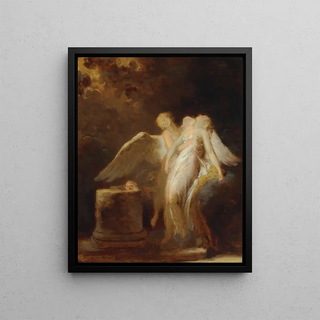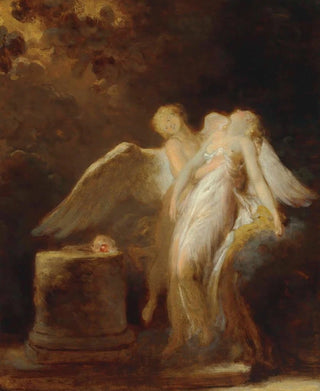Art print | The Sacrifice of the Rose - Jean-Honoré Fragonard Source: Reproduction | Le Sacrifice de la Rose - Jean-Honoré Fragonard


View from behind

Frame (optional)
"Le Sacrifice de la Rose" is an iconic art print by Jean-Honoré Fragonard, a master of the 18th century whose artistic genius captured the essence of rococo. This painting, both delicate and evocative, invites the viewer to immerse themselves in a universe where beauty and sensuality intertwine. Fragonard, as an artist, has always sought to express intense emotions through refined compositions and vibrant colors. In this work, he depicts a moment of passion and sacrifice, where the rose, symbol of love, becomes the focal point of a visual narrative rich in meaning. The scene, imbued with lightness, suggests a thwarted love story, while highlighting the artist's exceptional talent for creating enchanting atmospheres.
Style and uniqueness of the work
Fragonard's style is characterized by a lightness and fluidity that manifest in every brushstroke. In "Le Sacrifice de la Rose," the artist uses pastel colors and play of light to create a sense of movement and vitality. The figures are portrayed with almost aerial grace, and the floral details, especially the rose, are crafted with meticulous care that reflects the artist's admiration for nature. This art print stands out for its intimate atmosphere, where the viewer is invited to share a moment of closeness between the characters. The composition, dynamic and asymmetrical, draws the eye and guides the gaze through the scene, reinforcing the idea of an ongoing story. Fragonard succeeds in transcending mere portraiture to offer a true emotional experience, where each element contributes to the overall harmony of the work.
The artist and his influence
Jean-Honoré Fragonard, born in 1732 in Grasse, is one of the most brilliant representatives of the rococo movement. Trained at the Royal Academy of Painting and Sculpture, he quickly established himself thanks to his exceptional talent and innate sense of composition. Fragonard's influence extends beyond his era, shaping subsequent generations of artists who

Matte finish

View from behind

Frame (optional)
"Le Sacrifice de la Rose" is an iconic art print by Jean-Honoré Fragonard, a master of the 18th century whose artistic genius captured the essence of rococo. This painting, both delicate and evocative, invites the viewer to immerse themselves in a universe where beauty and sensuality intertwine. Fragonard, as an artist, has always sought to express intense emotions through refined compositions and vibrant colors. In this work, he depicts a moment of passion and sacrifice, where the rose, symbol of love, becomes the focal point of a visual narrative rich in meaning. The scene, imbued with lightness, suggests a thwarted love story, while highlighting the artist's exceptional talent for creating enchanting atmospheres.
Style and uniqueness of the work
Fragonard's style is characterized by a lightness and fluidity that manifest in every brushstroke. In "Le Sacrifice de la Rose," the artist uses pastel colors and play of light to create a sense of movement and vitality. The figures are portrayed with almost aerial grace, and the floral details, especially the rose, are crafted with meticulous care that reflects the artist's admiration for nature. This art print stands out for its intimate atmosphere, where the viewer is invited to share a moment of closeness between the characters. The composition, dynamic and asymmetrical, draws the eye and guides the gaze through the scene, reinforcing the idea of an ongoing story. Fragonard succeeds in transcending mere portraiture to offer a true emotional experience, where each element contributes to the overall harmony of the work.
The artist and his influence
Jean-Honoré Fragonard, born in 1732 in Grasse, is one of the most brilliant representatives of the rococo movement. Trained at the Royal Academy of Painting and Sculpture, he quickly established himself thanks to his exceptional talent and innate sense of composition. Fragonard's influence extends beyond his era, shaping subsequent generations of artists who






